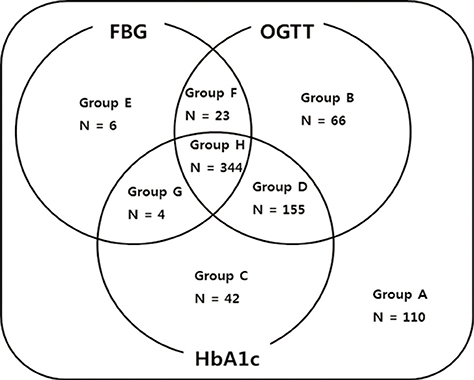Lab Med Online.
2014 Apr;4(2):71-76.
Comparison of the Characteristics of Patients with diabetes as Diagnosed Using Three Different Tests
- Affiliations
-
- 1Department of Laboratory Medicine, Hanyang University School of Medicine, Seoul, Korea. ikpark@hanyang.ac.kr
Abstract
- BACKGROUND
Diabetes diagnosis can be made using different laboratory tests, including the fasting plasma glucose (FPG) test, 75-g 2-h oral glucose tolerance test (2-h OGTT), and hemoglobin A1c (HbA1c) test; however, these tests have different meanings. This study aimed at comparing patient characteristics based on the diagnosis using each of these 3 tests.
METHODS
A total of 750 adults suspected of having diabetes and aged > or =18 years underwent the following tests on the same day: FPG, 2-h OGTT, HbA1c, insulin, general chemistry, and routine urinalysis. The patients were divided into 8 groups based on the combination of positive and negative results of each of the 3 tests, and the characteristics of the patients were compared among groups.
RESULTS
In the group that tested positive for all 3 tests, the FPG, 2-h OGTT, HbA1c, homeostasis model assessment for insulin resistance, alanine transaminase, triglyceride, and urine glucose positive values were higher than those of the group that tested positive using the 2-h OGTT and HbA1c test. In the group that tested positive using the 2-h OGTT, blood urea nitrogen was higher than that of the group that tested positive using the HbA1c test.
CONCLUSIONS
The characteristics of the patients differed between the tests that yielded positive diagnostic results. This may be related to the fact that the 3 tests indicate different states of glucose metabolism. The results of the 3 tests were significantly different; therefore, it may be more effective to combine the results of the 3 tests to comprehensively describe patient characteristics.
Keyword
MeSH Terms
Figure
Reference
-
1. Report of the Expert Committee on the Diagnosis and Classification of Diabetes Mellitus. Diabetes Care. 1997; 20:1183–1197.2. American Diabetes Association. Standards of medical care in diabetes. Diabetes Care. 2010; 33:S1. S11–S61.3. Nathan DM, Turgeon H, Regan S. Relationship between glycated haemoglobin levels and mean glucose levels over time. Diabetologia. 2007; 50:2239–2244.
Article4. Nathan DM, Kuenen J, Borg R, Zheng H, Schoenfeld D, Heine RJ. A1c-Derived Average Glucose Study Group. Translating the A1C assay into estimated average glucose values. Diabetes Care. 2008; 31:1473–1478.
Article5. Matthews DR, Hosker JP, Rudenski AS, Naylor BA, Treacher DF, Turner RC. Homeostasis model assessment: insulin resistance and beta-cell function from fasting plasma glucose and insulin concentrations in man. Diabetologia. 1985; 28:412–419.
Article6. Wallace TM, Levy JC, Matthews DR. Use and abuse of HOMA modeling. Diabetes Care. 2004; 27:1487–1495.
Article7. National Diabetes Data Group. Classification and diagnosis of diabetes mellitus and other categories of glucose intolerance. Diabetes. 1979; 28:1039–1057.8. American Diabetes Association. Diagnosis and classification of diabetes mellitus. Diabetes Care. 2012; 35:S1. S64–S71.9. Sacks DB. A1C versus glucose testing: a comparison. Diabetes Care. 2011; 34:518–523.
Article10. Edelman SV. Type II diabetes mellitus. Adv Intern Med. 1998; 43:449–500.11. Guyton AC, Hall JE, editors. Gyuton and Hall Textbook of Medical Physiology. 12th edition. Saunders: Elsevier;2011.12. Esteghamati A, Noshad S, Khalilzadeh O, Khalili M, Zandieh A, Nakhjavani M. Insulin resistance is independently associated with liver aminotransferases in diabetic patients without ultrasound signs of nonalcoholic fatty liver disease. Metab Syndr Relat Disord. 2011; 9:111–117.
Article13. Koskinen J, Magnussen CG, Kähönen M, Loo BM, Marniemi J, Jula A, et al. Association of liver enzymes with metabolic syndrome and carotid atherosclerosis in young adults. The Cardiovascular Risk in Young Finns Study. Ann Med. 2012; 44:187–195.
Article14. Yun JE, Kim SY, Kang HC, Lee SJ, Kimm H, Jee SH. Alanine aminotransferase is associated with metabolic syndrome independently of insulin resistance. Circ J. 2011; 75:964–969.
Article15. Gao F, Pan JM, Hou XH, Fang QC, Lu HJ, Tang JL, et al. Liver enzymes concentrations are closely related to prediabetes: findings of the Shanghai Diabetes Study II (SHDS II). Biomed Environ Sci. 2012; 25:30–37.16. Angulo P. Nonalcoholic fatty liver disease. N Engl J Med. 2002; 346:1221–1231.
Article17. Yueh CY, Chen JH, Lee LW, Lu CW, Parekh B, Chi CC. Elevated alanine aminotransferase is associated with metabolic syndrome but not consistently associated with impaired fasting glucose or type 2 diabetes mellitus. Diabetes Res Clin Pract. 2011; 94:64–70.
Article18. Andres R. Aging and diabetes. Med Clin North Am. 1971; 55:835–846.
Article19. Reaven GM. Does age affect glucose tolerance? Geriatrics. 1977; 32:51–54.20. Carrera T, Bonamusa L, Almirall L, Navarro JM. Should age and sex be taken into account in the determination of HbA1c reference range? Diabetes Care. 1998; 21:2193–2194.
Article21. Yang YC, Lu FH, Wu JS, Chang CJ. Age and sex effects on HbA1c. A study in a healthy Chinese population. Diabetes Care. 1997; 20:988–991.
Article22. Burden ML, Basi M, Burden AC. HbA1c local reference ranges: Effects of age, sex and ethnicity. Practical Diabetes Int. 1999; 16:211–214.
Article23. Inoue M, Inoue K, Akimoto K. Effects of age and sex in the diagnosis of type 2 diabetes using glycated haemoglobin in Japan: the Yuport Medical Checkup Centre study. PLoS One. 2012; 7:e40375.
Article24. World Health Organization. Definition, diagnosis and classification of diabetes mellitus and its complications: report of a WHO consultation. Part 1: diagnosis and classification of diabetes mellitus. Geneva: World Health Organization;1999.25. Lee YW, Cha YJ, Chae SL, Song J, Yun YM, Park HI, et al. Effectiveness of sodium fluoride as a glycolysis inhibitor on blood glucose measurement: comparison of blood glucose using specimens from the Korea National Health and Nutrition Examination survey. Korean J Lab Med. 2009; 29:524–528.
Article
- Full Text Links
- Actions
-
Cited
- CITED
-
- Close
- Share
- Similar articles
-
- Comparison of Insulin-Treated Patients with Ambiguous Diabetes Type with Definite Type 1 and Type 2 Diabetes Mellitus Subjects: A Clinical Perspective
- Interventional Strategies Based on the Types of Family Characteristics for the Diabetes Educator
- Clinical and molecular characteristics of infantile-onset diabetes mellitus in Egypt
- Social Welfare Approaches for Patients with Concurrent Diabetes and Cancer
- Characteristics of the Diabetic Life Cycle


